As in The Matrix, this movie's subject is the amazing similarities between the real and virtual worlds. In the year 1999, the lead characters, Hannon Fuller, and his business associate Douglas Hall, create a computer generated virtual world on the 13th floor of a Los Angeles office building that recreates Los Angeles as it was in 1937.
As the photos on the following pages show, people who want to log on to this computer program stretch out on a bed, and the program's data is then transferred to their brains. Whoever connects to the system acquires a virtual personality back in 1937. When the data is loaded into his brain, for example, Douglas Hall—a wealthy businessman and successful company executive in 1999—becomes a bank cashier named John Ferguson, living in the year 1937.
Once the data is loaded, anyone connecting to the system suddenly finds himself in the 1937 environment, with everything—buildings, cars, clothes—of authentic 1937 vintage. When people enter this simulated world, what surprises most is that both of their lives seem similarly real. In both, they feel the coolness of water and air blown by the wind and experience the same fears and excitement in the situations they encounter.
As the film progresses, people connected to the system begin to realize that the life in 1999 Los Angeles, which they thought was real, is itself a specifically designed program! Everything they thought to be real up until then—their companies, jobs, cars, computer systems, families, friends—are actually imaginary. In reality, the year is 2024, and all the events projected as their "real lives" are part of a simulation. The film's most amazing aspect is that the characters connect to a simulator-within-the-simulator and live lives that, in these successive virtual environments, all have stunningly convincing similarities with reality.
The stills on the opposite page show Douglas connecting to the simulation and the transfer to him of 1937 banker John Ferguson's personality.

Douglas Hall – John Ferguson consciousness transferring
User: Douglas Hall
Scanning Complete
Preparing user for download into simulation.
Program link: John Ferguson
Aligning user to program
Ready for download.
Mr. Grierson, 117 West Whinston, Pasadena.
Consciousness Transferring
Transference beginning.
Download complete.
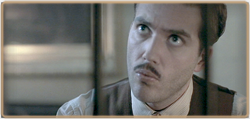
Even though Douglas's body is motionless, once connected to the simulator, he finds himself alive in the year 1937 as a bank cashier named John Ferguson. Even though every detail appears perfectly realistic, the old-fashioned cars, the people he meets, his own clothes and physical appearance—everything is part of a vision created in his brain by artificial signals.
Despite the fact that Douglas is the designer of this system, he is amazed by his appearances and the realistic environment he is in, as the movie still below demonstrates. Spending a long time in front of a mirror, he even observes his hair, moustache, and the color of his skin.
Because of 1937 John Ferguson's weird behavior, his bank manager tells him that he looks appalling and should take a break. But 1999 Douglas Hall, deeply affected by the realistic quality of his computer-generated life, is proud of designing such a system.
Douglas Hall : I think I look pretty good.
As pointed out extensively in the previous chapters, things we perceive as the "external world" are only the effects of electrical impulses on the brain. The blue sky when you look out the window, the soft chair you are sitting on, the scent of the coffee you drink, the ringing of the phone, even your body—all are your brain's interpretation of electrical signals.
Were it possible to send the required electrical signals with the aid of a computer, just as in this film, you could have experienced the same feelings with the same degree of authenticity. As you've seen, artificial stimulation can create a living, convincing world inside our heads. With the help of simulators, we can now recreate some aspects of our lives realistically. With a special glove, for example, it's possible to feel the sensations of stroking a cat, shaking someone's hand, washing your own hands under a tap, or touching a hard object—without these actions taking place physically. More sophisticated systems let you feel that you're playing golf, skiing, driving a race car or flying an aircraft. In reality, none of these environments exist. This shows absolutely that humans experience sensations only in their brains and are not interacting with the "originals."
In The Thirteenth Floor, computers create virtual lives, indistinguishable from real ones. Through the simulation machine, characters in the film connect to different times and environments where they live just as in their "real" lives.
In the following dialogue, Whitney, one of the system's designers, explains the simulation they are working on to detective McBain:
| Detective McBain | : | The whole thing's a giant computer game? |
|---|---|---|
| Whitney | : | No, not at all, it doesn't need a user to interact with it to function. Its units are fully-formed, self-learning cyber beings. |
| Detective McBain | : | Units? |
| Whitney | : | Electronic, simulated characters. They populate the system. They think they work, they eat... Let's just say that they're modeled after us. Right now we have a working prototype: Los Angeles, circa 1937. |
| Detective McBain | : | Why '37? |
| Whitney | : | Fuller wanted to start by recreating the era of his youth. You see, while my mind is jacked in, I'm walking around experiencing 1937. My body stays here and holds the consciousness of the program link unit. |
As you can gather from this dialogue, in the simulated environment there is no reality whatsoever, only artificial signals. There is no need for eyes to see, ears to hear, or no body to feel. Someone stretched out on the bed can feel himself somewhere else in a different time, simply by some data being transferred through the computer.
Our books on this subject offer some explanations:
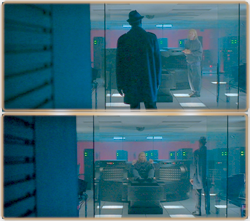 • All our senses work more or less in the same way. All the stimuli (sounds, smells, tastes, sight, hardness, etc.) from objects that exist outside of ourselves, are transmitted, via the nervous system, to the brain's perceptual centers. All the stimuli reaching the brain are in the form of electrical impulses. For instance, streams of light—photons—reflected from external objects reach the retina at the back of the eye; in the process of seeing, they are converted into electrical signals, then transmitted by the optic nerve to the brain's visual center where, in an area of a few cubic centimeters, we perceive a vivid, colorful, three-dimensional world. The same basic process applies to our other senses. Cells in the tongue convert different flavors into electrical signals, scents are transmitted by cells in the epithelium in the nose, feelings of touch (hardness, softness etc.) by receptor cells under the skin; and sound by a special mechanism in the ear. All are then forwarded to be perceived in the relevant areas of the brain. If you are drinking a cup of tea, special cells under your skin convert the warmth of the cup into electrical signals sent to the brain. Likewise, when you take a sip, the tea's strong scent, sweet taste and the brownish color are all converted into electrical currents transmitted to the brain. When you put the cup down onto the table, the sound of its making contact with the tabletop is received by the ear and sent to the brain as an electrical impulse. All these perceptions are interpreted by separate sensory centers in the brain, in conjunction with one another. As a result of these interpretations, you think you are drinking tea, while everything is really taking place in your brain's sensory centers. In other words, everything begins and ends in the sensory centers in the brain, but you imagine that these perceptions are reality. You go wrong in thinking your perceptions are for real, because you have no proof what the original outside your head is like. Were there any complications in your optic nerves, vision would instantly disappear. Likewise, if there were a problem with your auditory nerves, the sounds would cease to exist. (Articles-II, "Splendid Science Beyond Matter," pp.112-113)
• All our senses work more or less in the same way. All the stimuli (sounds, smells, tastes, sight, hardness, etc.) from objects that exist outside of ourselves, are transmitted, via the nervous system, to the brain's perceptual centers. All the stimuli reaching the brain are in the form of electrical impulses. For instance, streams of light—photons—reflected from external objects reach the retina at the back of the eye; in the process of seeing, they are converted into electrical signals, then transmitted by the optic nerve to the brain's visual center where, in an area of a few cubic centimeters, we perceive a vivid, colorful, three-dimensional world. The same basic process applies to our other senses. Cells in the tongue convert different flavors into electrical signals, scents are transmitted by cells in the epithelium in the nose, feelings of touch (hardness, softness etc.) by receptor cells under the skin; and sound by a special mechanism in the ear. All are then forwarded to be perceived in the relevant areas of the brain. If you are drinking a cup of tea, special cells under your skin convert the warmth of the cup into electrical signals sent to the brain. Likewise, when you take a sip, the tea's strong scent, sweet taste and the brownish color are all converted into electrical currents transmitted to the brain. When you put the cup down onto the table, the sound of its making contact with the tabletop is received by the ear and sent to the brain as an electrical impulse. All these perceptions are interpreted by separate sensory centers in the brain, in conjunction with one another. As a result of these interpretations, you think you are drinking tea, while everything is really taking place in your brain's sensory centers. In other words, everything begins and ends in the sensory centers in the brain, but you imagine that these perceptions are reality. You go wrong in thinking your perceptions are for real, because you have no proof what the original outside your head is like. Were there any complications in your optic nerves, vision would instantly disappear. Likewise, if there were a problem with your auditory nerves, the sounds would cease to exist. (Articles-II, "Splendid Science Beyond Matter," pp.112-113)
 |
|---|
| Everything we taste, smell, hear and feel are only perceptions in the brain. |
Adnan Oktar: There is a glorious system everywhere in the world and a symmetrical regularity, the golden ratio, in all created things. For example, I am now seeing you in full color in my brain. A soul is seeing you inside my brain. The human eye does not see. The eye just transmits an image to the brain. We see everything transmitted to the brain as an electrical current in the form of an image. The soul sees it, and this is an extraordinary thing. And the ear does not hear. It just converts sound waves into electrical energy and sends them to the brain. They reach our brain and the soul in our brain hears them, hears them as music. There are only sound waves on the outside. There is no color on the outside. There is no light. Light is an interpretation of our brain's. Color is also interpreted by our brain. It is something made up of light waves. The Sun is pitch black and dark. Matter is also transparent, stemming from the nature of the atom. It looks transparent because the nucleus, neutrons and protons all have spaces between them. But we perceive it as colored and three-dimensional in our brains. It is inappropriate to describe the existence of a power that creates such a structure using skeptical language. Of course they should explicitly say that Allah created it. (Mr. Adnan Oktar's ABC TV interview, 10 November, 2009)
In light of some recent discoveries, scientists have come to an interesting conclusion: In reality, our world is in utter darkness, because today it is known that "light" is a wholly subjective term. In other words, it's an experience taking place in the brain.
There is no light outside, really. Light bulbs do not emit light, neither do your car's headlights, not even our biggest known light source, the Sun. Our experience of light is produced by photons reaching the retina at the back of our eyes, where cells convert them into electrical signals that we come to perceive as "light." If the cells of our eyes perceived photons as heat, we would never have terms like "light," "darkness," or "color" and therefore, would look at objects only in terms of "warm" or "cold."
In The Thirteenth Floor, upon Douglas Hall's return from the artificial but realistic environment of 1937, he has the following exchange:
| Whitney | : | How's the lighting? Textures? |
|---|---|---|
| Douglas Hall | : | Colorization needs work, but the units don't notice. |
| Whitney | : | What are they like? |
| Douglas Hall | : | They're as real as you and me. |
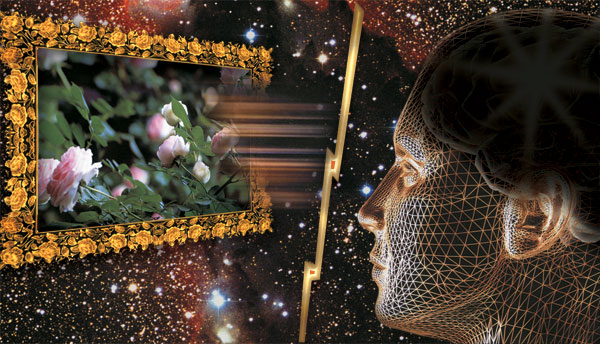 |
|---|
| Someone looking at a rose garden is in reality interacting with the perception of roses in the brain. |
The "reality" depicted in the film is in fact true. By means of artificially created signals, quantities like color or light can be experienced quite realistically. Some examples from our books on this subject explain:
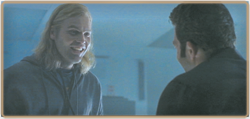 • The brain is insulated from light;the inside of the skull is absolutely dark. Therefore, the brain itself has no contact with light ... You can watch a burning candle at length. However, your brain never has direct contact with the candle's original light. Even at the moment you perceive the candle's light, the inside of your brain is pitch dark. We watch a colorful and bright world inside our dark brain.(The Evolution Deceit, 7th edition, p.218)
• The brain is insulated from light;the inside of the skull is absolutely dark. Therefore, the brain itself has no contact with light ... You can watch a burning candle at length. However, your brain never has direct contact with the candle's original light. Even at the moment you perceive the candle's light, the inside of your brain is pitch dark. We watch a colorful and bright world inside our dark brain.(The Evolution Deceit, 7th edition, p.218)
• As we all know, light cannot penetrate the skull. In other words, our safely contained brain is in utter darkness. Yet in this darkness, we see the blue ocean waters, the green trees, colorful flowers, brilliant Sun and every shade and hue. ... If we saw the true state of the objects outside ourselves, we wouldn't perceive this external brilliance, colors and light, because the images would bounce off our skulls and never reach the visual center in our brain. If this is so, then how do we see this brilliant light of the Sun and moon? How do images of the bright chandeliers in our lounge form in the brain, where light can never reach?(Articles-II, "Splendid Science Beyond Matter," pp.112-113)
• The light we know and understand does not reside outside our brains. Light, as we perceive it, is also formed within our brain. What we call light, supposedly in the outside world, consists of electromagnetic waves and energy particles called photons. When these electromagnetic waves reach the retina, only then does light, as we experience it, come into existence. Consequently, light comes about as a result of the effects caused in us by some electromagnetic waves and particles. In other words, no light outside our bodies creates the "light" we see in our brains. There is only energy; and when it reaches us, we perceive a bright, colorful world.(Matter: The Other Name for Illusion, pp.27-28
Just as with light, the experience of colors forms in our brains too. When photons from the Sun hit an object, it reflects these in photons of different wavelengths. Reaching the eye, the retina converts them into electrical impulses. Carried to the visual center in the brain, they are interpreted as colors. But these are personal, specific interpretations within ourselves; there is no light and no colors in the real world. A defect in our eye, or the different eye structures in other creatures, will convert the photons into different electrical signals, resulting in our perceiving the exact same object in a wholly different way.
Below are some passages dealing with this subject from our books:
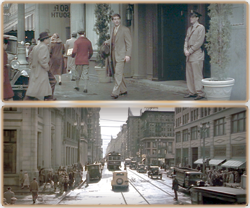 • Starting from the time we are born, we deal with a colorful environment and see a colorful world. But there isn't one single color in the universe. Colors are formed in our brains. Outside, there are only electromagnetic waves of different amplitudes and frequencies. What reaches our brains is the energy from those waves. We call this "light," although this isn't the bright and shiny light we know. It's merely energy. Our brains interpret this energy by measuring the different frequencies of waves, and we see "colors." In reality, the sea is not blue, the grass is not green, the soil is not brown and fruits are not colorful. They appear as they do because of the way we perceive them in our brains. Both color and light exist in our brains. We do not actually see a red rose as red simply because it is red. Our brain's interpretation of the energy that reaches our eye leads us to perceive that the rose is red. (Matter: The Other Name for Illusion, p.28)
• Starting from the time we are born, we deal with a colorful environment and see a colorful world. But there isn't one single color in the universe. Colors are formed in our brains. Outside, there are only electromagnetic waves of different amplitudes and frequencies. What reaches our brains is the energy from those waves. We call this "light," although this isn't the bright and shiny light we know. It's merely energy. Our brains interpret this energy by measuring the different frequencies of waves, and we see "colors." In reality, the sea is not blue, the grass is not green, the soil is not brown and fruits are not colorful. They appear as they do because of the way we perceive them in our brains. Both color and light exist in our brains. We do not actually see a red rose as red simply because it is red. Our brain's interpretation of the energy that reaches our eye leads us to perceive that the rose is red. (Matter: The Other Name for Illusion, p.28)
• Color blindness is proof that colors are formed in our brains. A small injury in the retina can lead to color blindness. A person affected by color blindness is unable to differentiate between red and green colors. Whether an external object has colors or not is of no importance, because the reason why we see objects colorful is not their being colorful. This leads us to the conclusion that all of the qualities that we believe belong to the object are not in the outside world, but in our brains. However, since we will never be able to go beyond our perceptions and reach the outside world; we can never know the colors in the world outside. (Matter: The Other Name for Illusion, p.31)
Most people believe that they smell the scent of a flower with their noses. Like all our other senses, smell too is an interpretation of the brain and works in a similar way. After entering the nose, a flower's scent molecules are converted in the epithelium into electrical signals. These signals reach the brain's olfactory center, where they are perceived as the scent of a daisy, rose, or some other flowers. Were the relevant signals sent to your brain by artificial means, you could smell these scents without the flowers themselves.
| Allah brought you out of your monthers wombs knowing nothing ar all, and gave you hearing, sight andhearts so that perhaps you would show thanks. (Surat an-Nahl: 78) |
|---|
| |
In The Thirteenth Floor's simulated environment, scents are perceived in a perfectly realistic way. Mr. Grierson, a bookstore keeper in 1937, is a virtual character crafted to resemble the elderly Hannon Fuller, who connects to the simulator and uses this person's body to spend time in Mr. Grierson's virtual environment. He listens to 1930s music, watches the dances of that era and acquires a social circle there. As one of the program's requirements, when he leaves the system, the body he's been using continues its old life. Therefore, Mr. Grierson—bookstore keeper in the virtual year of 1937—can't quite remember what he experienced, or else considers his memories to be only products of his imagination. In one exchange of dialogue, he says:
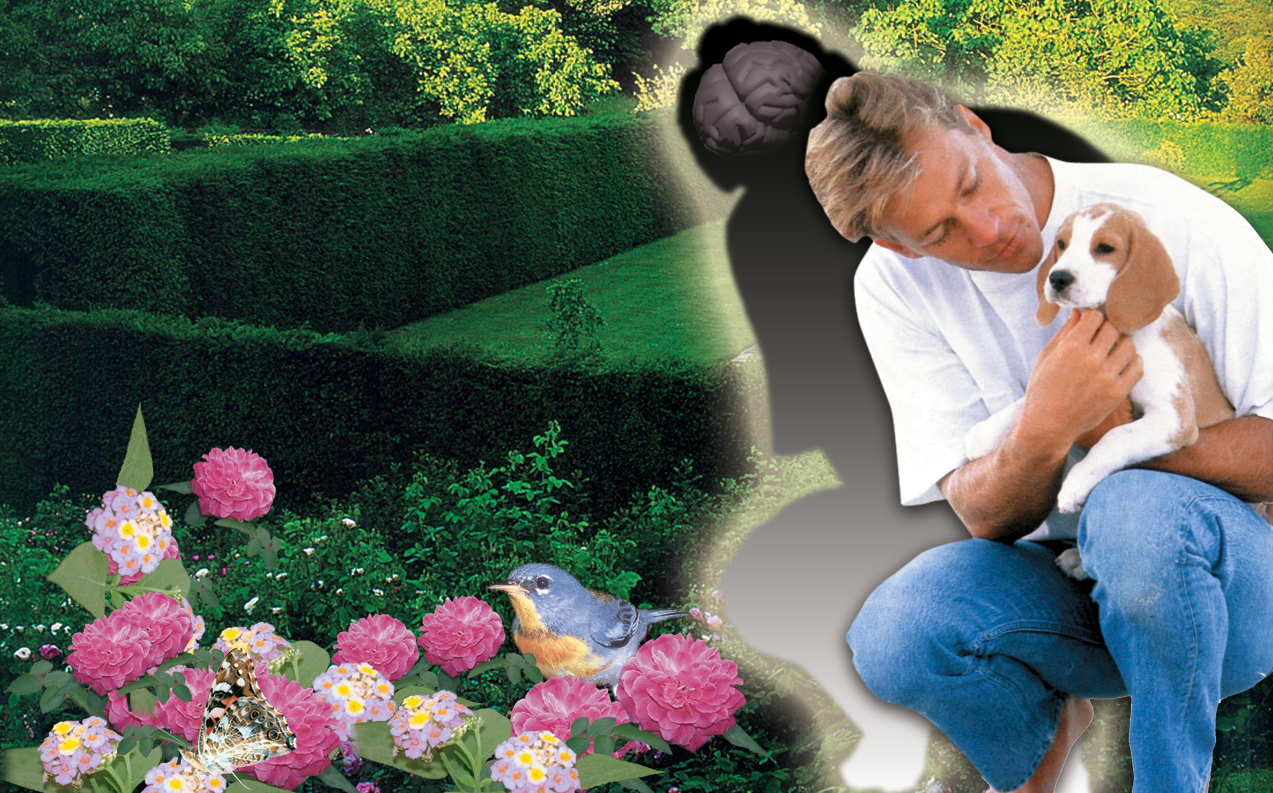
| Mr. Grierson | : | When I wake up, I even have a perfume smell all over me. |
|---|---|---|
| Douglas Hall | : | Real or imagined? |
As this scene shows, the units in the virtual environment perceive smells realistically, via computer-generated data transmitted to them, without the existence of any perfume in the real world. Some passages from our books explain this matter:
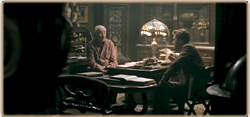 • You suppose that the end-effects formed in your center of smell are the scents of the objects outside. However, just as the image of a rose exists in your visual center, so its smell resides in your olfactory center … (The Evolution Deceit, 7th edition, pp.223-224)
• You suppose that the end-effects formed in your center of smell are the scents of the objects outside. However, just as the image of a rose exists in your visual center, so its smell resides in your olfactory center … (The Evolution Deceit, 7th edition, pp.223-224)
• To understand that smell is only a sensation, consider dreams. When people dream, just as all images are seen realistically, smells too are perceived as if they were real. For example, a person who goes to a dream restaurant may choose dinner amid the aroma of the foods on the menu. Someone who dreams of a trip to the seaside senses the distinctive smell of salt water, and someone who dreams of a garden would experience the pleasure of magnificent scents. Likewise, someone who dreams of choosing a perfume would be able to distinguish the smells of the different perfumes, one by one. Everything is so realistic that when people awaken, they are often surprised to realize they were dreaming. (Matter: The Other Name for Illusion, p.39)
Adnan Oktar: "I am the Rich" (Surah Fatir, 15) says Allah, and you own nothing. We look at what enters our brains. We also see that there is nothing more than images in our brains. We put money on the table, but when we press the sides of our eyes that money disappears. The money is an image in our brains. Cars and houses, too. Gold is an image. Allah says we are poor. What kind of poor? Absolute poverty. You have nothing, says Allah. "You are the poor in need of Allah," He says. "Allah is the Rich beyond need." (Surah Fatir, 15) says Allah. "I give that image to you," He says. You feel it in your brains... You are perceiving it in your brain now. You do not feel touch at your finger tips. The finger is three-dimensional, but when it combines with the image everything is perceived in the same place, and that is why you imagine you are feeling a sense of touch at your finger tips. There is no feeling in the finger tips. Not in that sense. The only feeling is in the brain. You are seeing an image of me bow. I appear to be at a distance, though we are in the same place. Your microphone and mine are in the same place. We are forming in the same place in the brain... We have a material reality on the outside, but we are transparent there. That stems from the structure of the atom. But there is total darkness on the outside. We perceive photons as light. There are sound waves on the outside. Our brains are like radios. It reaches our brain, and the brain turns it into sound. The ear inside the brain hears. These ears are all deaf. The ears are just tools. The ears are tools that convert vibrations into electricity. They are devices that turn sound waves from the outside into electrical. One cannot hear anything in the ear. The same is with the nose. People do not smell in their noses. They turn chemical gases and substances from the outside into electrical energy and send them to the brain, and we smell inside the brain. In other words, we smell a rose in our brains. The same with the image of the rose. It is dark on the outside, and though there is light it is transparent. So that green and red form in our brains, they are perceptions. There is no scientists who disagree. Irreligious, Buddhists, Muslims or Christians, they are all agreed on that. It is a scientific fact. (Mr. Adnan Oktar's Asu TV interview, 11 January, 2010)
In the late 19th century, people who faced a movie screen for the first time believed the objects they saw on the screen to be real. They began to panic when they saw a train racing towards them. Much more convincing effects are achieved today by means of special glasses which create holograms (3-D view). People wearing these glasses, believe the imaginary scenes they're watching are real, respond with fear and excitement. Even though they're well aware that they're interacting with a virtual environment, they can't help becoming absorbed in the recreated environments of this new technology.

This situation is also true for our lives: We believe in the real world because of the perfectly realistic appearance.
The Thirteenth Floor points out how technology can mislead. In the virtual year 1937, a character named Ashton reads a letter he wasn't supposed to, written by Hannon Fuller, one of the system's founders. When Ashton finds out that his entire life until then was not real, that he lives in a virtual world, first he thinks it's all a joke. Later, when he sees that this environment, created specifically for him, comes to a predetermined end, he goes berserk. But none of his actions can change the reality that he is living in a virtual environment. Becoming aggressive, he furiously demands that Douglas Hall, one of the system's founders, tell him the truth. The following dialogue takes place between them:
| Ashton | : | When I read it, I thought it was a gag. The world's a sham. Fat chance! But I'm not stupid, Mr. Hall. I watched you and Ferguson do the old switch-er-oo. And all that stuff about going to "the ends of the earth." |
|---|---|---|
| Douglas Hall | : | What stuff? |
| Ashton | : | I did exactly what the letter said. I chose a place I'd never go to. I tried to drive to Tucson. I figured, whatever, I've never been to the countryside. And I took that car out on the highway. I was going over 50 through that desert. After a while, it was the only car on the road. It was just me, the heat and the dust. I did exactly what the letter said. "Don't follow any road signs and don't stop for anything. Not even barricades." But just when I should've been getting closer to the city. Something wasn't right. There was no movement, no life. Everything was still and quiet. And then I got out of the car. And what I saw scared me to the depths of my miserable soul. It was true. It was all a sham. It ain't real. |
| Douglas Hall | : | Why would Fuller write about the limitations of the simulation? I know them. |
| Ashton | : | I'm asking the questions now. I want to know why... Now I want you to show me what is real. Is this real? Is that real blood? |
When Ashton discovers that his environment is actually virtual, he refuses to acknowledge it. To prove his point, he even shoots Douglas in the leg and asks him if the blood flowing from the wound is real. But when someone gets injured, because the blood from his leg, the pain and fear he feels, are all perceptions. Therefore, nothing changes. The fact of someone experiencing pain or fear does not represent evidence that he is experiencing the original of matter.
The same is true for us. We can't prove that we experience the originals of the perceptions we experience in our brains. It's impossible for us to tell whether these perceptions derive from some artificial source. Because no matter what happens to us, we can never step outside our brains.
Some people who disagree, without pondering this subject, say things like, "Step in front of a truck, and you'll understand whether or not matter is real." But even when the truck runs us over, still we live in our brains: The sensation of being run over, like the vision of the truck and the anxiety of trying to escape it are all brain-based perceptions. Likewise if someone strikes you, the blow of his hand, the sensation of pain on your face and the reddening of the skin are all experienced in the brain.
Some passages from our books are in line with the subject:
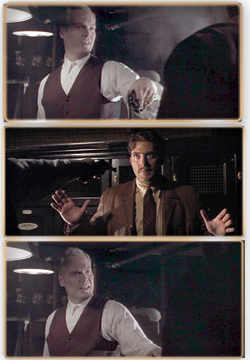 • Objection: "The pain when a knife slips and cuts my hand and the blood that flows are not images. Moreover, my friend was with me and saw it happen." Reply: ... Those who say this kind of thing ignore the fact that not only sight, but the other senses like hearing, smell and touch, also happen inside the brain. That's why they say, "I may see the knife in my brain, but the sharpness of the blade is a fact. Just look how it has cut my hand." However, the pain in that hand, the warm wet blood, and all the other perceptions are still formed within the brain. That a friend witnessed the incident changes nothing, because the friend is also formed in the same visual center of his brain as the knife. The speaker could experience the exact same feelings in a dream—the way he cut his hand with a knife, the pain in his hand, the image and the warmth of his blood. In that dream, he can also see the friend who saw him cut himself. Yet his friend's existence doesn't imply that what he sees in his dream is reality.
• Objection: "The pain when a knife slips and cuts my hand and the blood that flows are not images. Moreover, my friend was with me and saw it happen." Reply: ... Those who say this kind of thing ignore the fact that not only sight, but the other senses like hearing, smell and touch, also happen inside the brain. That's why they say, "I may see the knife in my brain, but the sharpness of the blade is a fact. Just look how it has cut my hand." However, the pain in that hand, the warm wet blood, and all the other perceptions are still formed within the brain. That a friend witnessed the incident changes nothing, because the friend is also formed in the same visual center of his brain as the knife. The speaker could experience the exact same feelings in a dream—the way he cut his hand with a knife, the pain in his hand, the image and the warmth of his blood. In that dream, he can also see the friend who saw him cut himself. Yet his friend's existence doesn't imply that what he sees in his dream is reality.
What if someone came up in that dream and said, "When you cut your hand, what you saw is just perceptions. That knife isn't real, nor are the blood and the pain. They are just events you're witnessing in your mind"? The person would not believe him and would object. He might even say: "I am a materialist. I do not believe in such claims. There is reality in everything I see now. Look, can't you see the blood?" (Matter: The Other Name for Illusion, pp.183-184)
• It's impossible for us to reach the original of the material world. All objects around us are apprehended through one or more means of perception such as sight, hearing, and touch. Our brain, processing the data in the visual and other sensory centers throughout our lives, confronts not the "original" of the matter existing outside us, but rather the copies formed inside our brain. (Timelessness and the Reality of Fate, p.32)
• … From computer, you can also send electrical signals related to your body to your brain. If we sent to your brain the electrical correlates of senses such as sight, hearing, and touch that you perceive while sitting at a table, your brain would think of itself as a businessman sitting in his office. This imaginary world will continue so long as the computer keeps stimulations coming. It will never become possible for you to understand that you consist of nothing but your brain. This is because what is needed to form a world within your brain is not the existence of a real world but rather the stimuli. It is perfectly possible that these stimuli might be coming from an artificial source, such as a recording device or a different source of perception.(Eternity Has Already Begun, pp.29-30)
 |
|---|
| The hummingbird in the picture is only the sum total of perceptions to the beholder. |
In the following dialogue, Douglas's connection to the simulation gets disrupted, returning him to real life. In the virtual world, his friend Whitney—in the person of Ashton—is trying to kill him. In the virtual world, Douglas experiences fear so realistic that upon returning to real life, he's out of breath. Still trying to defend himself, he even punches Whitney.
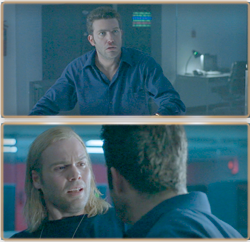
| Douglas Hall | : | He tried to kill me. |
|---|---|---|
| Whitney | : | Who? |
| Douglas Hall | : | Ashton. He found out his world isn't real. This is a mistake. This whole project, this experiment. We are screwing with people's lives! |
| Whitney | : | Now you're talking crazy. I know you just had a bad trip ... |
| Douglas Hall | : | "Bad trip?" These people are real. They are as real as you and me. |
| Whitney | : | Yeah, that's because we designed them that way. In the end, they're just a bunch of electronic circuits. |
As this scene dramatizes, it's possible to live in an unreal world, believing it to be the real life. Douglas, despite being one of the system's designers, and despite his friend's reminding him that the people he encountered were the sum total of electronic circuits, still has trouble believing his experience wasn't real.
While engaged in this argument about the emulation of reality by a system they designed, they themselves live in an artificial environment. But they aren't aware of this, and so believe their world to be real.
Many passages in our books touch on the possibility of creating the impression of reality by artificial stimulation:
Towards the end of the film, viewers are surprised to learn that the characters who designed the system, living a virtual life when they connect to it, are really with their bodies in 2024. The life of Douglas Hall, who believes himself to be living in Los Angeles in 1999, is itself a dream. He's living a fantasy inside a fantasy.
This can be compared to dreaming within a dream. Even though a dream has no material reality, yet we can experience realistic feelings and even think that we are sleeping and waking as a part of our everyday lives. We can even tell our dream-friends about very realistic dreams we dreamt in our dream.
Consequently, it's possible to experience an artificially created fantasy in which we realize it to be so. Douglas, facing such a situation, can't overcome the shock of this reality.
| Douglas Hall | : | How many simulated worlds like this are there? |
|---|---|---|
| Jane Fuller | : | Thousands. Yours is the only one that ever created a simulation within the simulation. Something we never expected! |
Adnan Oktar: The inside of our brains is a pitch dark box. I see you and myself so clearly that I see a bright and wondrous world. Your chair really appears to be at a distance from mine, though I see one single image. Allah creates it in the same place, but perfectly clearly. For example, there are many famous firms such as Siemens and Philips, but they have never achieved such a quality of picture. Look at Allah's artistry. Hundreds and thousands of engineers are working. They use thousands of components. And hundreds of engineers work to produce each component. But even though they work for days and months they have never been able to obtain the image created by Allah that forms in such a tiny piece of flesh. But a Philips television does not come into being by chance. Since Akai tape recorders and other musical equipment and radios do not come into being by chance, why should that image come into being by chance? Would one not ask oneself who it is who sees a full color image inside the pitch black brain? It is both a very high quality, three-dimensional and completely believable image, and the fact that there is also someone seeing it is quite amazing. There is no other explanation. The fact that someone sees the image is truly wondrous. Because another eye is needed in order to see the image in the brain. Another eye is needed to see the image transmitted by the first. And so on ad infinitum. There is a huge miracle here, but people fail to realize. For instance, who hears this sound? All right, there may be sound somewhere, but the presence of someone to hear it... Or what is this sense of touch? Someone feels a sensation of touch. Or the taste of an orange. What is an orange? We perceive its sharpness and smell and immediately recognize it. But who recognizes that smell? We know the smell of a rose. But how could atoms in muddy water on the ground think to set up such a system? Atoms know nothing of the smell of a rose; they are blind and deaf. No matter what you do or add in.
You can produce an image in a robot's brain, in the area that resembles a brain, but you cannot make the robot see it. That seeing is something totally different. It is not something that can be described with physics or geography or chemistry. It is completely metaphysical, and there is no other explanation. Even if a robot were made that could not be it. I mean, even if a robot were built with an image appearing in its brain, through hundreds of thousands of engineers working day and night, putting thousands of components together. Say they make a perfect robot as a result, but that robot would not have come about by chance. What can chance do? If we throw some sand around it will just scatter, and you will never get the national anthem from it. (Mr. Adnan Oktar's Uşak ART TV interview, August 2008)
People think they're interacting with their real bodies, because they can touch it, provide for its needs, and feel pain. Just as with all other "outside" objects, our own body is a perception too, and we can never reach its material reality. The pain when we cut our finger is a perception, as is stilling hunger with a decent meal. It too is a perception. Artificial stimuli can provide the same feelings of satisfaction without us having to eat a meal. For this reason, we can never be certain about the physical reality of our bodies. It's the soul who feels the touch, the pain, and who reads this book.
 |
|---|
| Someone who falls asleep at work might see himself drowsing at the beach in his dream—and in that sleep, be dreaming of spending time with his child. In other words, he could be dreaming within his dream, despite the lack of physical actuality. |
Consider this subject from another perspective: The book appears to you at an approximate distance of 30 centimeters. You see walls around you, and your being seated on a chair at a certain height from the floor creates the impression that you're located somewhere inside a room. In reality, this environment is an illusion created by your mind. Because of this mistaken belief, you have the sensation of living in the world. Actually, the opposite is true: everything is inside of you.
In the accompanying photos, the virtual character Ashton, who has just learned the truth, is seen speaking with Douglas. Ashton is experiencing the shock of discovering that for all those years, he has lived an illusion he thought to be reality. But Douglas, who created that virtual system, shares his feelings because he is part of yet another virtual environment.
| Douglas Hall | : | No, Ashton ... I'm just like you. Just a bunch of electricity. |
|---|---|---|
| Ashton | : | What are you talking about? |
| Douglas Hall | : | It's all smoke and mirrors. Just like your world. We're nothing but a simulation on some computer. |
| Ashton | : | But the letter said ... |
| Douglas Hall | : | Everything was fake? The letter was meant for me. Fuller was talking about my world. |
| Ashton | : | So what are you saying? You're saying there's another world on top of this one? |
| Douglas Hall | : | That's right. |
| Ashton | : | I don't understand. |
| Douglas Hall | : | Fuller found out about it. |
These characters realize they've been living in a virtual environment with illusionary bodies, without the existence of a material reality. Nothing they ever saw or experienced was real. In another scene, Douglas explains, "None of this is real. You pull the plug. I disappear. And nothing I ever say nothing I ever do will ever matter."
When these characters discover that they're part of a virtual reality, they realize that everything they've ever experienced happened outside of their control, determined by whoever developed their virtual world.
| ...It may be thar you hate something when it is good for you and it may be that you love something when it is bad for you Allah knows, and you do not know. (Surat al-Baqara: 216) |
|---|
| |
Our own situation is very similar to theirs. Allah controls everything in the world we live in; He has created every detail therein as part of our trial. Someone who realizes that everything he sees and hears is in fact a perception in his mind Allah has created, trusts in the infinitely merciful and compassionate Creator of us all, instead of suffering from sadness, fear, or panic.
It's appropriate to remind the reader of the some passages from our books on this subject:
• … Allah gives everyone the impression that he can change things, making his own choices and decisions. For example, when a person wants a drink of water, he doesn't say, "If it is my fate, I will drink," and sit down without making a move. Instead, he drinks a predetermined amount of water from a predetermined glass. But throughout his life, in everything that he does, he thinks he's acting according to his own desire and will. The person who submits himself to Allah and to the fate He created, knows that everything he does is according to the will of Allah, even despite his sense that he's accomplished it all himself. Other people mistakenly assume that they've done everything with their own intelligence, under their own power. (Matter: The Other Name for Illusion, pp.146-147)
• … Everything in heaven and Earth is Allah's and a manifestation of Allah. Allah is the only absolute Being. The other beings whom He has created are not absolute beings, but appearances. All the individuals observing the appearances that Allah has created are all spirits from Allah.When people grasp the secret of this great knowledge, they will attain great conscious clarity, and the haze enshrouding their spirits will lift. Everyone who understands it will freely submit to Allah, love Him and fear Him… Those who understand this amazing fact will view things from a different perspective and embark on a totally different life. (Matter: The Other Name for Illusion, p.103)
| Nothing occurs either in the earth or in yourselves, without its being in a Book before We make it happen. That is something easy or Allah. That is so that you will not be grieved about the things that may have escaped you or exult about the things that come to you. Allah does not love any vain or boastful man. (Surat al-Hadid: 22-23) |
|---|